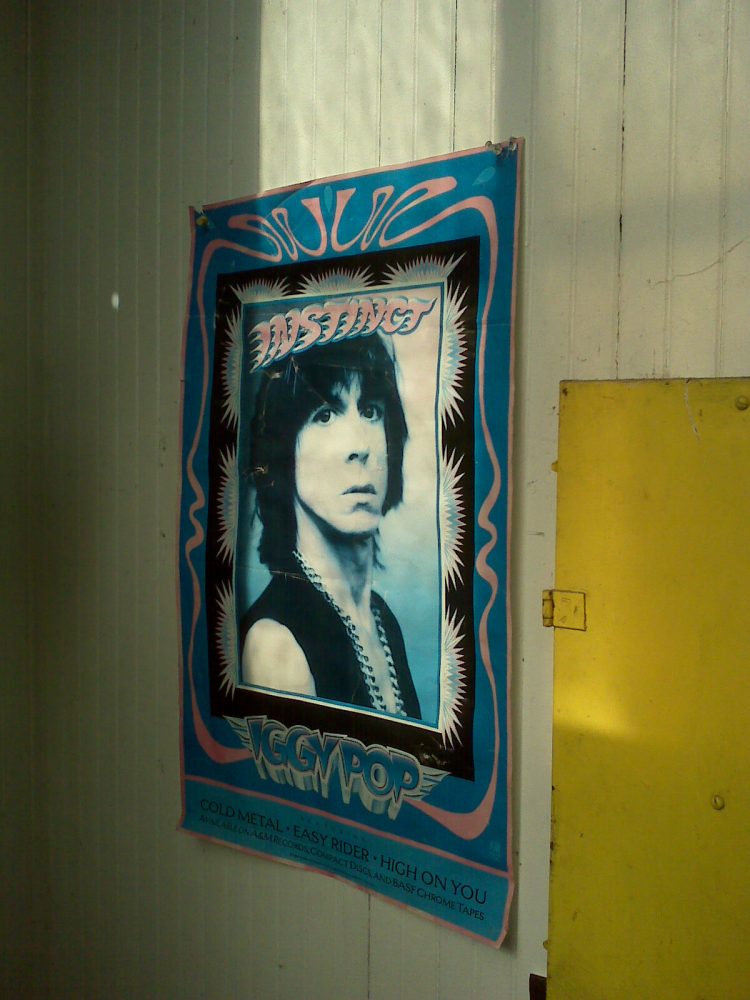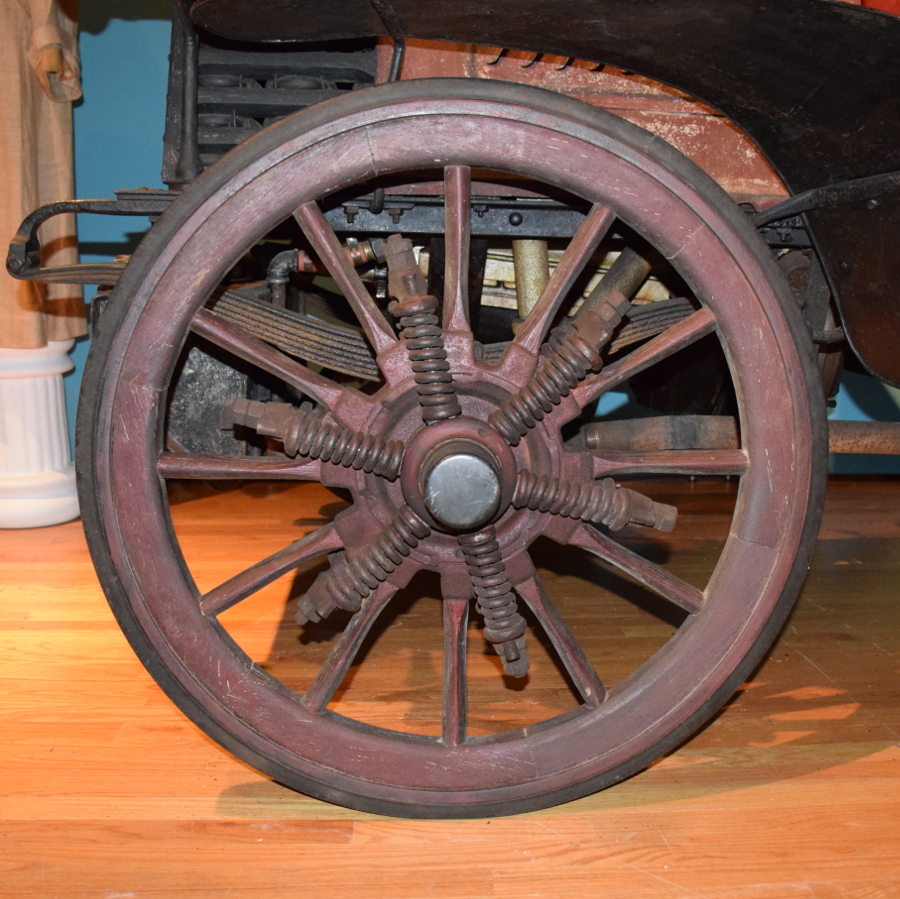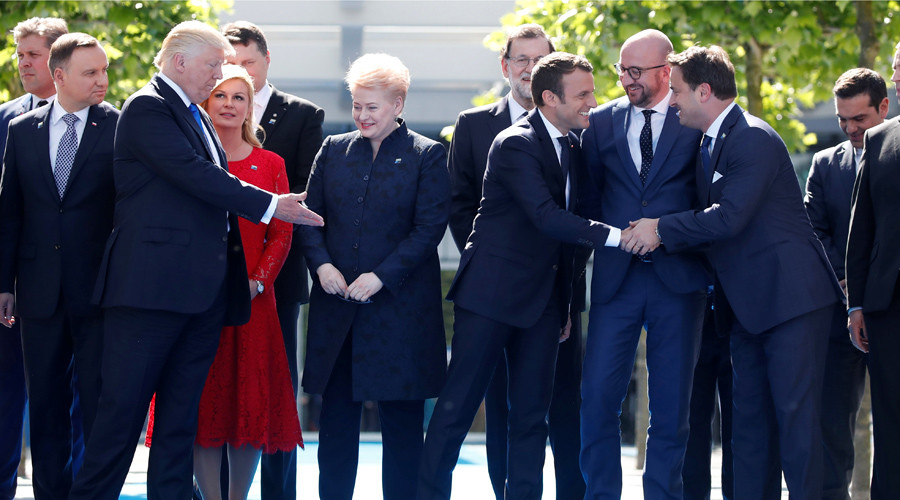
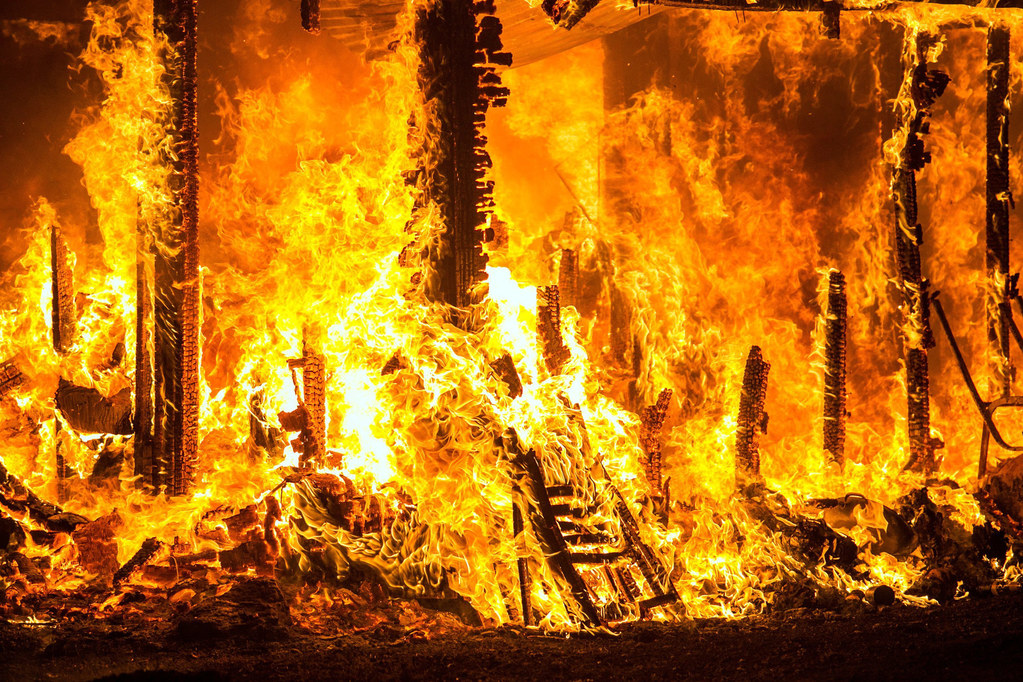
Whenever I meet another glassblower I ask them “when did you first get in trouble for starting a fire?” They always have a story.
I was about five when my mother called the fire department on me because I liked to play with matches. I can’t remember if this was before or after my friend Marta and I got caught playing doctor in her closet, but I digress. I was in the alley behind our neighbors garage, an old wooden shed, when the fire truck rolled up and several large men in uniforms climbed down. They gently but firmly explained why I shouldn’t play with fire. They made a big impression on me and that day I stopped playing with matches.
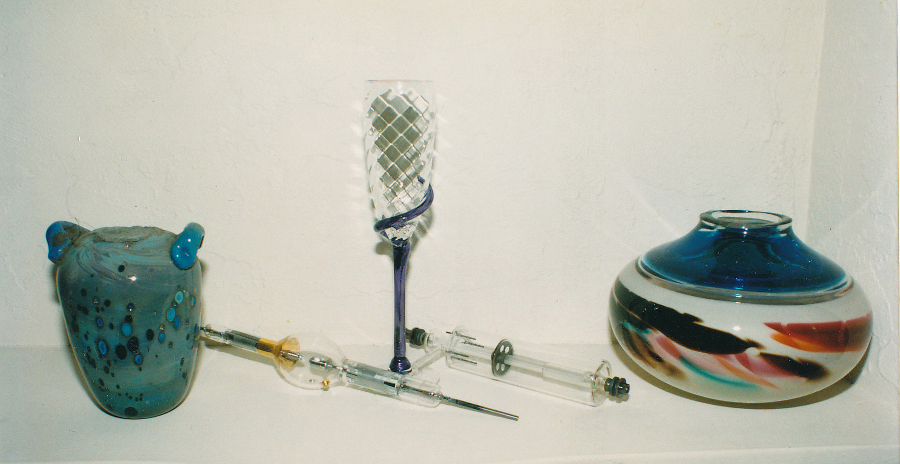
“Wherever humans have gone in the world, they have carried with them two things, language and fire. As they traveled through tropical forests they hoarded the precious embers of old fires and sheltered them from downpours. When they settled the barren Arctic, they took with them the memory of fire, and recreated it in stoneware vessels filled with animal fat….A human body at rest devotes roughly one-fifth of its energy to the brain, regardless of whether it is thinking anything useful, or even thinking at all. Thus, the unprecedented increase in brain size that hominids embarked on around 1.8 million years ago had to be paid for with added calories either taken in or diverted from some other function in the body. Many anthropologists think the key breakthrough was adding meat to the diet. But Wrangham and his Harvard colleague Rachel Carmody think that’s only a part of what was going on in evolution at the time. What matters, they say, is not just how many calories you can put into your mouth, but what happens to the food once it gets there. How much useful energy does it provide, after subtracting the calories spent in chewing, swallowing and digesting? The real breakthrough, they argue, was cooking.” (Adler, Jerry)
My most vivid school memory is the afternoon the Principle came into our class, talked to our teacher for a minute and made her cry. He then told us that the President of the United states of America had been shot and killed. The only other strong memory I have, is finishing my class work and taking out a book to read. The teacher came over and told me to put the book away, that I was supposed to be doing my work. I showed her that I was finished and she told me I should just sit quietly until everyone else was finished. From that day to this, I realized most of the rules schools have instituted are not there to support students’ learning.
My father was a rock hound, which made me a pebble pup. He and his friends all cut and polished the rocks we found and made jewelry in their home workshops. My mother was from New Mexico, so we often visited her family and drove and hiked all over the American Southwest collecting rocks. Being a kid, I wasn’t allowed to use the lapidary machinery or torches. My father died suddenly and his friends decided to show me how to use the equipment safely because they knew, as a junior member of the Whittier Gem and Mineral Society, I would try and make jewelry on my own. Because I could identify most American gemstone they also encouraged me to help organize the donations to the Juniors’ fund raising table at the annual Gem and Mineral Show. I appreciated their thoughtfulness in keeping me occupied and engaged as I grieved.
Always an A student, my grades plummeted. There were no grief counselors available to elementary school students back then so the administrators decided to skip me a grade. I have no idea what they were thinking but the week I turned 12 I found myself the youngest kid in Katherine Edwards Junior High School. I had never had to switch classrooms during the school day so the ‘boys’ counselor showed me around my first day and wished me luck. The good news was they had a band, so I could continue to play clarinet. Being ‘husky’, the band director encouraged me to learn the sousaphone. …and I never wrote to thank him.
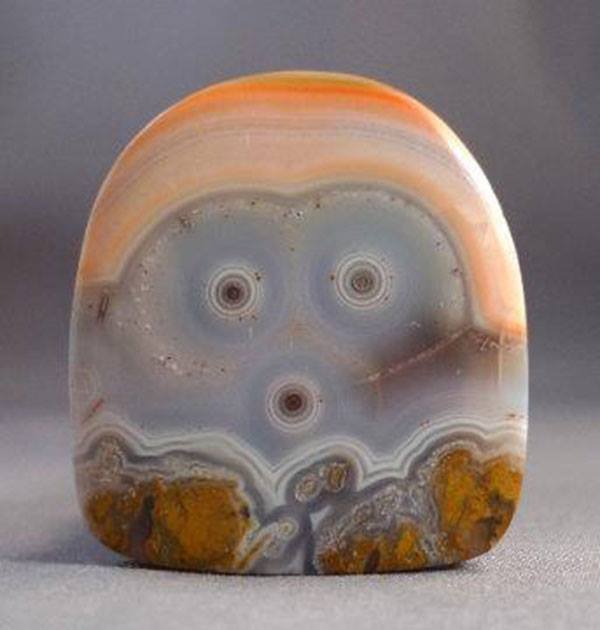
“Every culture ever studied has been found to make music, and among the oldest artistic objects known are slender flutes carved from mammoth bone some 43,000 years ago — 24,000 years before the cave paintings of Lascaux.…The new paper “takes a very innovative approach and is of great importance,” said Josef Rauschecker, director of the Laboratory of Integrative Neuroscience and Cognition at Georgetown University. “The idea that the brain gives specialized treatment to music recognition, that it regards music as fundamental a category as speech, is very exciting to me.”In fact, Dr. Rauschecker said, music sensitivity may be more fundamental to the human brain than is speech perception. “There are theories that music is older than speech or language,” he said. “Some even argue that speech evolved from music.”” (Angier, Natalie)
After WWII, my mother was working in a bank and renting a house in Hollywood with five other “girls.” My father was a counter man at the local Ford dealership and trading handyman work for music lessons. Evelyn Pennick had been a vaudeville performer and owned a Hollywood music store. She and her female partner were my mother’s landladies; that is how my parents met. Andy and Ev also owned several other properties including a cabin on Big Bear Lake and a cottage and a sailboat in Newport Beach. I always wondered how they acquired all this property.

After I was born in Hollywood, my parents moved us to a small Mid-Western Quaker village, just east of East LA. When I was nine, my dad and I started taking music lessons at Ev’s store in Hollywood. He studied Flamenco Guitar and I learned to play the clarinet. I’ll never forget the picture of Evelyn in a cocktail skirt and fishnet stockings playing two clarinets at once. It was an inspiration to me in more ways than one. I didn’t learn what a lesbian was until years later.
I was fourteen when my cousin talked her mom into taking us to see “Hair” at the Aquarius Theater on Sunset Blvd. for her birthday. It was 1969 and the original road company didn’t wear flesh colored tights. Two years later, Elvin Bishop and Big Brother and the Holding Company played at my high school. It was the first time I saw real rock bands. By then, I had played in the high school orchestra, marching band, pep band/jazz combo and the orchestra for the theater department’s annual musical. I also joined a local youth marching band because they had traveled to the Calgary Stampede in Canada and represented Whittier at Richard Nixon’s Inauguration in Washington D.C. The year I joined we were selected to march in the 37th Annual Sugar Bowl Parade in New Orleans. I bought my first cocktail, a hurricane, on Bourbon St. in the French Quarter on New Year’s Eve. I was fifteen. I should have sent my junior high school band director a postcard.
I began taking classes at my local community college during my junior year in high school. There were no AP classes and I was bored. After I graduated from high school, I took a jewelry class and a glassblowing class thinking I would use a torch to make little trinkets to add to my jewelry, like I had seen on Olivera St. in Los Angeles. Instead, we all gathered in a utility room next to the ceramics studio, and the teacher told us “as soon as we finish building this furnace and kiln, we’re going to make glass and learn how to blow it. He had a degree in chemistry and ceramic design from Alfred University in New York, and a month later we were blowing the glass we had made, from a furnace we had built. We did not know it, but we were the second wave of the American Studio Glass Movement. I was eighteen and had found my life’s work, although it took a few more years to realize it.
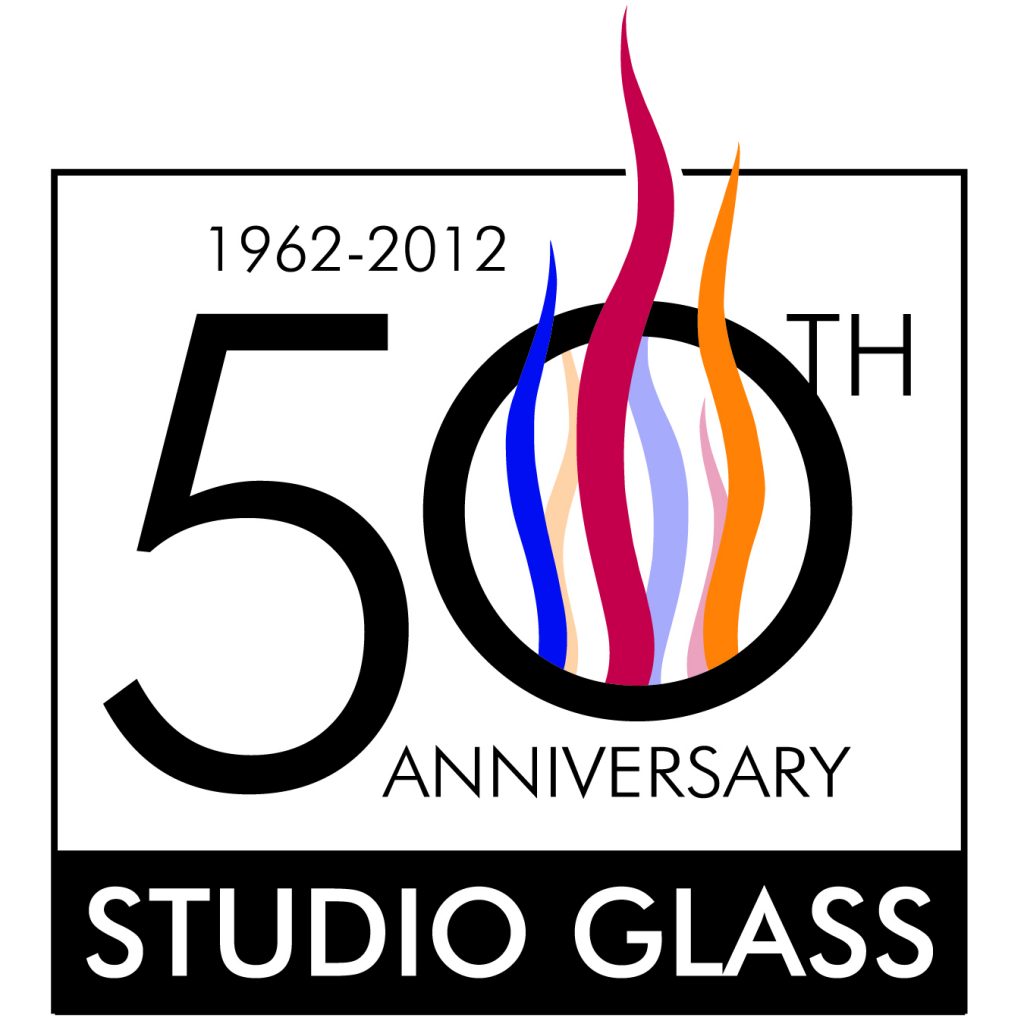
That summer my girlfriend Wendy and I drove a VW bus from LA to Vancouver, British Columbia, and then across the newly completed TransCanada Highway to St Johns, Newfoundland. We explored Boston, New York City and Washington DC. We had one flat tire, and gathered a lifetime of memories.
While driving across Ontario, which is nearly twice the size of Texas, we heard the Grateful Dead were playing in New York, so we decided to take a little detour to see them. We listened to the AM radio news that the roads were being closed, but since we were coming from the north through Buffalo, we drove right to the Watkins Glen Racetrack, parked the van and walked right in. It was the biggest crowd we had ever seen, and we had been to the Rose Bowl Parade. The Dead played all afternoon. It looked like a big storm was headed our way so, at Wendy’s insistence, we left without seeing The Allman Brothers and The Band. That concert turned out to be the largest in US history, 600,000 people, nearly twice the size of Woodstock. Wendy was right: it poured rain for the next couple days.
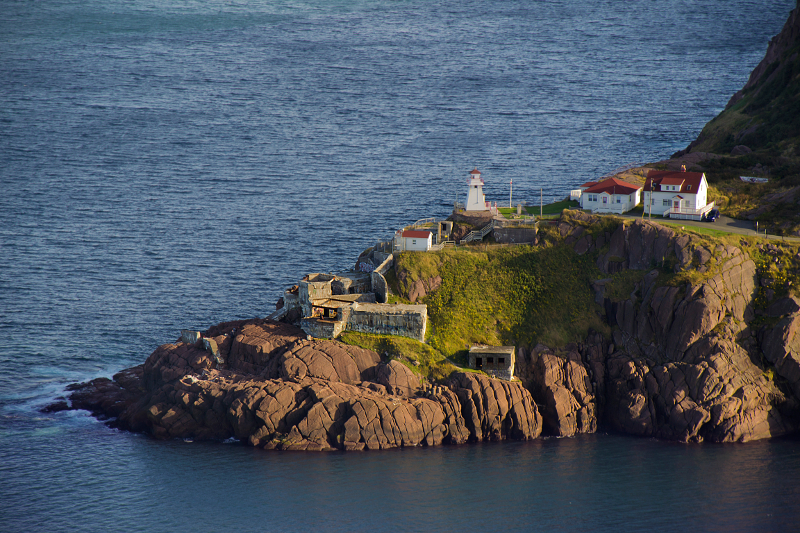
One morning, from the campground above St Johns, I saw three black wooden ships leaving the harbor. They were very low in the water and had wine colored square sails with black crosses. At lunch in the harbor, I asked about what I had seen. A harbor worker told me it was the Portuguese fishing fleet loaded with cod and headed home. The only sounds I had heard were the sails luffing, and asked if they had motors. I was told that they were the last of the traditional fishermen. This was twenty years before the collapse of the Atlantic northwest cod fishery. They sailed nearly three thousand miles each way without modern technology, the way it had been done for hundreds of years. It made me think of the Nina, the Pinta, and the Santa Maria, nearly 500 years before. At the time, I had never heard of a caravel.
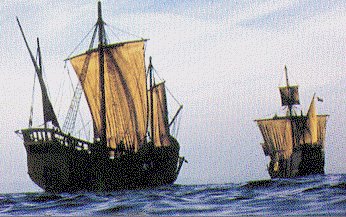
I tried many different jobs and kept taking night classes during the 70s. I managed a used book store and then managed a head shop that sold herbs and had a counter culture news rack. In response to ads I saw in East/West magazine, I spent the summer of ‘76 studying The Tao of Physics with Fritjof Capra, Tai Chi and Buddhism at Choyam Trungpa Rinpoche’s Naropa Institute in Boulder, Colorado. I then learned stone masonry through the Haystack School of Crafts (in Maine) at Paolo Soleri’s architectural megastructure project, Arcosanti, in central Arizona. In 1978, I spent most of the year working at Arcosanti; managing the cafe, leading a concrete construction crew, giving tours and working in the foundry making sand molds, pouring bronze and finishing the wind bells Soleri sells to finance his architectural projects. During that summer, I collaborated on the design of the food service for the Arcosanti Music Festival. The owners of the Arcosanti Cafe built food booths and I supervised the delivery of the organic food we served to the thousands of concert goers as well as the backstage area for VIPs and the performers. That ‘78 music festival still holds the record for the largest number of cars burned in a parking lot fire; the exact number will never be known, but it is ironic that it happened at an architectural project for a city without cars. That fall I worked in Soleri’s Cosanti bronze foundry in Phoenix. One day I went into the break room and picked up a Time magazine with a metal tub full of purple Kool-Aid on the cover. I read the article about the Jonestown massacre and decided I was done with visionary leaders.

I returned to LA and got a job making the glass equipment used to grow Silicon crystals and manufacture computer chips. With purity being crucial, this glassware is made from Pure Fused Quartz (PFQ) and requires a hydrogen/oxygen flame to reach the 4,000 degrees necessary to work it. This is the same flame that launches the space shuttle and makes quartz work the most dangerous form of glassblowing.
I continued taking art glass lessons from M. Rhys Williams at his Cactus Glassworks. Rhys received the first Master of Arts in Glass from Illinois State University, taught by one of the original American Studio Glass artists Joel Philip Myers. Often my blowing partner was Thurston LeVay, the owner of Glass Instruments, a high-tech glass shop in Pasadena, California. After years of lobbying he hired me and set me on my career path. I built high powered lamps and LASER’s in the daytime and took LASER technology classes at Pasadena City College at night. Rhys and I demonstrated glassblowing for several years at the LA County Fair and after I started working at Glass Instruments I set up a glass distillation column to demonstrate how glass is used in research.
After being laid off during the Reagan Recession, I spent a year studying Manufacturing Engineering at Cal Poly Pomona. For my work study job, I reopened the Cal Poly glass shop and repaired labware for Chemistry professors from Cal Poly and the Claremont Colleges. That was the first time I worked on a large research vacuum system. Unable to afford to continue on financial aid and work study, I moved to northern California to continue working as a scientific glassblower. I also continued making art glass at San Francisco State University and in Berkeley’s many glass studios.
In 1989 I answered a want ad in the San Jose Mercury News:
7052 to Kovar call Glastronics 408 727 8003.
Only an experienced glassblower and LASER maker would have known that 7052 is a Corning glass formula engineered to weld directly to the steel alloy Kovar to make hermetic (vacuum tight) seals for electro-optical devices.
In 1990, I cut two tendons and a nerve in my right (dominate) hand on a piece of glass. I was lucky to have Dr. Robert Markison in San Francisco as my surgeon. In addition to being one of the foremost hand surgeons in the world, Dr. Markison is a professional musician and amateur magician! After months of physical therapy, I returned to work. I mention this because for a year I had to work left handed and eventually became ambidextrous with Dr. Markison’s encouragement. I have always wondered how this experience altered my brain and my thinking.
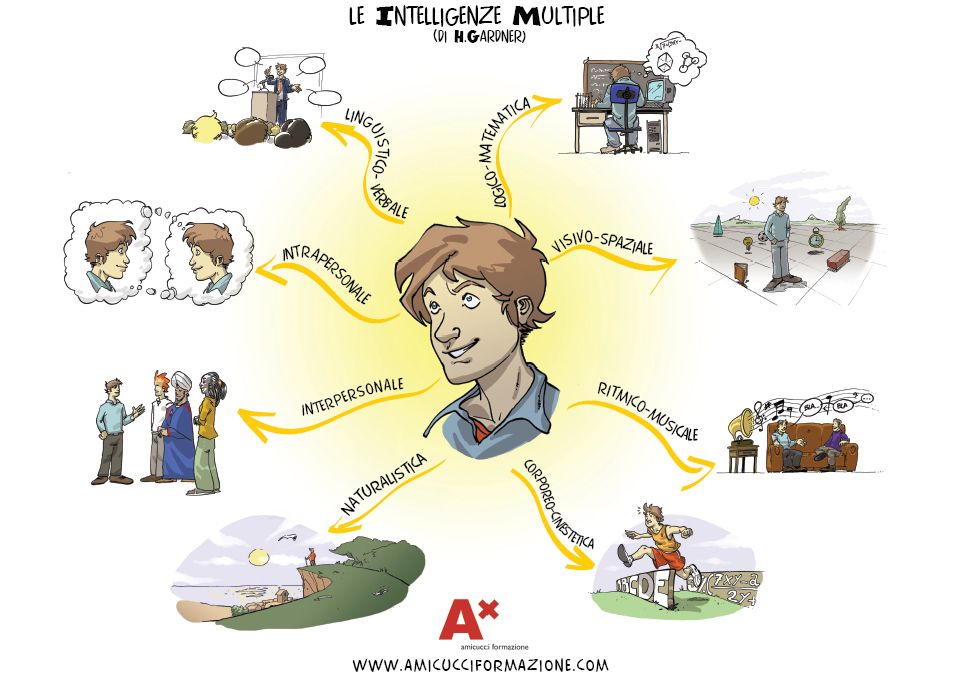
I am looking forward to documenting all my learning experiences and getting college credit through Metro State for many of my interests. Realizing the unusual circumstances of my life, I have always focused on my uniquely 20th Century American experience. Between my travels and my self-directed learning, I have explored the history and cultures of nearly every region in North America. I should start a list of every museum I can remember visiting.
For several years I was the Sunday manager at Moon News in Half Moon Bay, the finest bookshop and newsstand I’ve ever seen. I loved putting out all the Sunday papers and chatting with my regulars. And the 40% discount. I was downsized from my fulltime job as the Silicon Valley economic bubble collapsed. I had to sell the Early Modern beach house I had remodeled, overlooking the harbor in Half Moon Bay. I lost all health insurance (including dental, optical and lifetime long term care) and 1/3 of my private pension. I had spent fourteen years making high-intensity short-arc mercury vapor lamps for the production of computer chips.
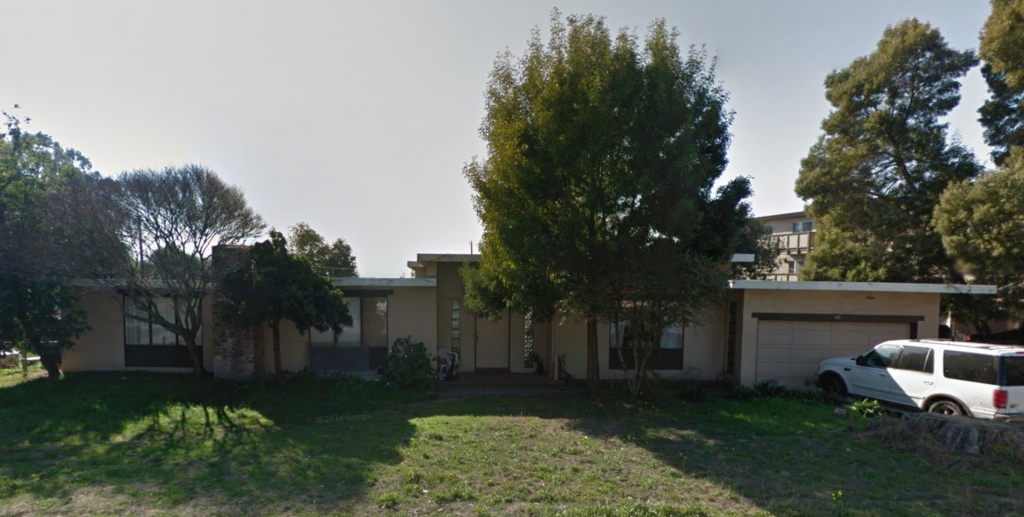
I returned to managing bookstores to make ends meet. Independent bookstores have become an endangered species thanks to Amazon. Moon News closed its doors in 2009. I also worked at the EastWest Bookshop, easily the largest New Age bookshop in California, now that the Bodhi Tree in LA is closed. I helped close the Books Inc. in the Stanford Shopping Center on the Stanford campus in Stanford, California and reopen it in the Town and Country Village in Palo Alto. All these stores hosted author readings and book signings and all the staff wrote short book reviews. I introduced and taped dozens of talks and wrote even more book reviews.
For a decade, I was involved with The Crucible Fire Arts Center in West Oakland. I took jewelry, machining and neon classes, and volunteered at many of their open houses and Fire Arts performances. I served as an intern in mold making department for Billy Heibert and as teacher’s assistant for Nick Diphillipo in the bronze foundry (who I had worked for at the Arcosanti and Cosanti foundries). I also filled in as the glassblowing technician and demonstrator, when Kier Logo injured his hand the week before the 2008 performances of the Fire Ballet Firebird: “L’oiseau de feu”.
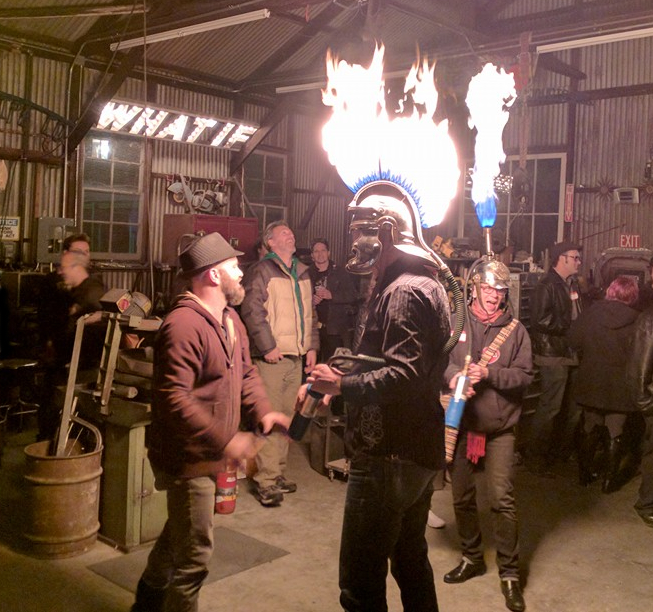
I worked a short time as the Senior Glassblower at the Richmond Technology Center, Chevron’s global research headquarters next to the Chevron Refinery in Richmond, California, where hundreds of researchers and their staffs explore energy solutions and support the refinery. Once the premier industrial glassblowing shop on the west coast, after decades of neglect it was the most dangerous and mismanaged place I have ever worked. While it had the most varied, interesting and challenging work I have ever done, I had no experience navigating huge bureaucratic organizations and was terminated for documenting safety violations.
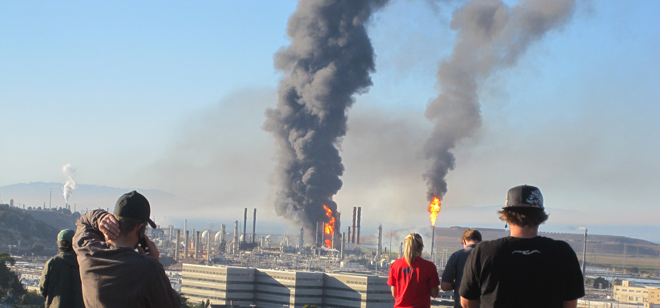
I was looking for a way to utilize my four decades of scientific glass blowing experience when I heard the new President say:
“…in this economy, a high school diploma no longer guarantees a good job. I urge the Senate to follow the House and pass a bill that will revitalize our community colleges, which are a career pathway to the children of so many working families. To make college more affordable, this bill will finally end the unwarranted taxpayer-subsidies that go to banks for student loans. Instead, let’s take that money and give families a $10,000 tax credit for four years of college and increase Pell Grants. And let’s tell another one million students that when they graduate, they will be required to pay only ten percent of their income on student loans, and all of their debt will be forgiven after twenty years – and forgiven after ten years if they choose a career in public service. Because in the United States of America, no one should go broke because they chose to go to college. And it’s time for colleges and universities to get serious about cutting their own costs – because they too have a responsibility to help solve this problem.”
– President Barack Obama State of the Union Speech January 2010
My monthly expenses were low, I decided to go to back to school and learn the skills needed to start my own business. At the time, I had a beautiful partner, shared a reasonably priced two bedroom apartment and had my dream motorcycle for transportation. I completed the Free Application for Federal Student Aid (FAFSA) in April 2010 and qualified for the maximum benefits, $5,500 in Pell Grants and Stafford Student Loans up to $9,500. I chose Laney Community College in Oakland because it was one of the few schools in the Bay Area that offered an Entrepreneurship Certificate and, having lived in Oakland when I first moved to the Bay Area, loved the diversity and working class vibe.
I submitted my paperwork to the Laney College Financial Aid Department and was told that I would receive funds in 6 to 12 weeks. I bought hundreds of dollars’ worth of textbooks and started school.
For the previous four years I had been under and unemployed. I started school with no savings and the expectation that I would receive my pre-approved funds in a timely manner. After three months, I ran out of money. I kept hoping to receive my funds and didn’t drop any classes. Returning to the FA office at the end of the semester I was told my FA Specialist was on vacation for a month. I asked who had been assigned his clients and was told ”no one.” I contacted my Congressman’s office, who wrote the US Department of Education on my behalf. The DOE made one phone call to the Peralta Community College District (PCCD) offices and assured my Congressman that everything was fine. My first response from the PCCD Director of Financial Aid was a voice message; “Mr. Wilson, you have bad grades and now have to petition for your financial aid.” No compassion or acknowledgment of their responsibility to support student success.
Although I followed every procedure on time, bureaucratic incompetence repeatedly kept me from receiving my pre-approved Federal Financial Aid. Eventually my partner left me, I was evicted and failed many classes. I repeatedly asked the financial aid office staff to do their job, and spoke directly to the Peralta Community College District (PCCD) Board of Trustees: for many reasons, the institution was unable to provide the support I needed (and had paid for with my taxes).
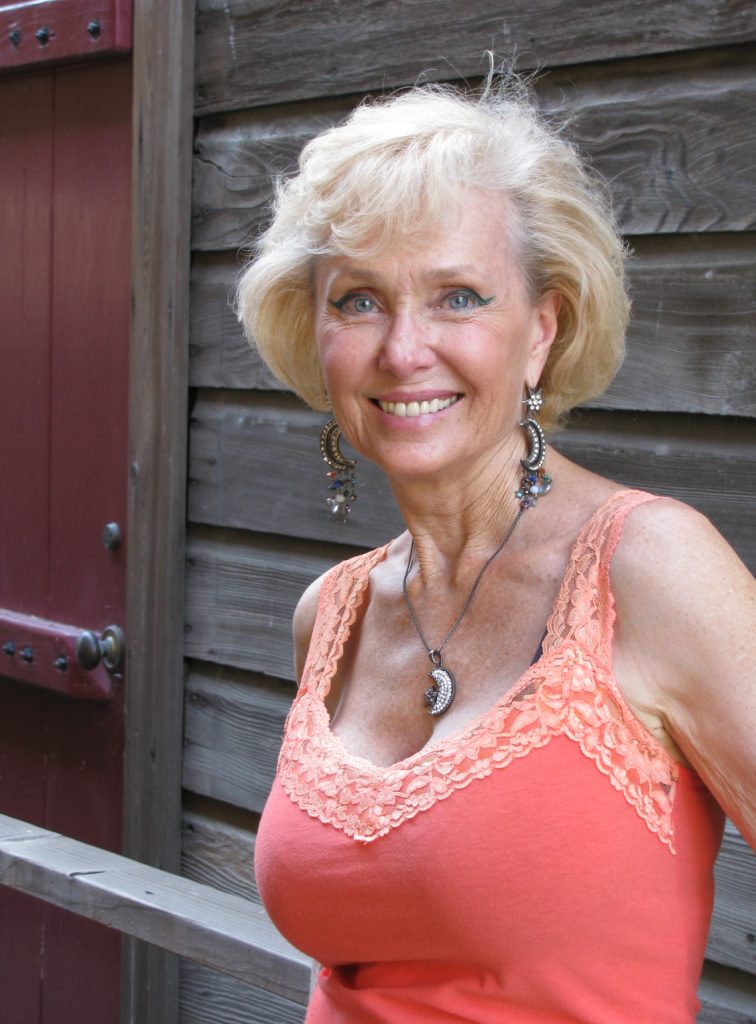
In the eight semesters I needed financial aid, I received it on time once, even after contacting my second US Representative. Despite all my pleading for help, all my belongings in storage were auctioned to pay my overdue storage fees. I lost my appliances, antique furniture, artwork, lapidary workshop, glassblowing tools, photographs and the family bible. I became just another homeless student on Oakland’s streets with one backpack, one laptop and two pairs of jeans.
In response, I became a student representative in the shared governance of the PCCD. In my two plus years as a student leader I learned to navigate the structure of the PCCD, helped create and run the new District-wide four college Peralta Student Council (PSC) and was elected its first Communications Officer. I chaired the working group that identified what students needed to support campus life, wrote the document describing the job and presented it to the Chancellor who hired four Directors of Campus Life to support student governments and clubs. I also spent a year as the only student on the PeopleSoft Financial Aid Solutions Steering Committee to computerize financial aid. We finally managed to install the software and force the staff to accept the new procedures. It was the third attempt in the seven years the District had owned the software. For my efforts, I was recognized as Student Leader of the Year by my peers on the PSC and by California Assembly member Rob Bonta.
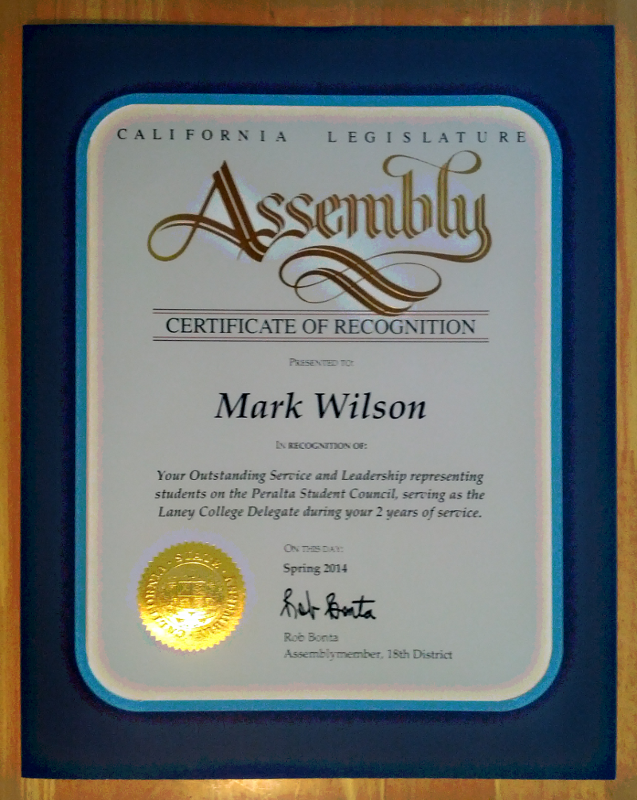
During this time, the PCCD Chancellor tried to destroy our new student organization by de-legitimating the Student Trustees as PSC officers. He claimed it was an accreditation problem but failed. Someone in the PCCD tried to block me from enrolling by illegally reversing my previous semester’s fee waivers which created a $900 debt to be cleared before I could enroll. I prevailed, but even going before the Board of Trustees (again) did not result in any punishment for the offenders. I stepped down from student government and changed colleges to escape the bullying. I have all the documents and emails. The Peralta Student Council has not met in the past two years.
In 2014, I couldn’t understand why I couldn’t register for an HTML class I wanted to take. The online system kept telling me that I had already taken the class, but I was sure that I hadn’t. I finally went through the process of generating an unofficial transcript online to double check before I went started the process of challenging the Registrar. There it was. I had taken the class during the most stressful period of my life and didn’t remember it. Apparently, this is one of the body’s protective mechanisms, to just wipe out the memory. I didn’t have to take the class; I already got an A.
When I was old enough to access my pension, I transferred to Berkeley City College (a sister school in the PCCD), changed my major to sociology and finished two Associate’s degrees with a 4.0 GPA during my final two years. This quote from Cathy Davidson’s new book confirms my lifelong suspicions:
“Apparently, University of Illinois professor of agriculture Herbert Mumford introduced the idea of grades to the American Meatpackers Association soon after Mount Holyoke adopted them. The meatpackers worried, though, that it was difficult to reduce something as complex as the quality of sirloin or chuck to an A, B, C, D, or F. So, from the beginning, they insisted that, along with the grade, the written comments of the meat inspector be tied to each and every piece of meat. What we would now call the “metadata” traveled with each piece of graded meat. Strangely, educators were less skeptical about applying grades to student learning. They were quick to take on a variety of standardized measurements that reduced the complexities of intelligence, aptitude, and achievement to a single alphabetic or numerical score.”
— (Davidson, Cathy N)
I’ve been documenting the educational conferences, online courses and webinars I’ve attended over the past three years, as well as the research I’ve been doing on eportfolios, Open Education, Networked Knowledge Organization Systems, graph databases, semantic metadata and the philosophy of semiotics. After a conversation during the Digital Humanities Summer Institute at the University of Victoria, BC, this summer: I realized that my ‘finishing a Bachelor’s in public using Free and Open Source Software to create a learning eportfolio on my own domain’ idea is actually a Digital Humanities project itself. I took two courses at UVic to move this forward; ‘Open Access and Open Social Scholarship’ and ‘TEI and Metadata.’ That led me to explore metadata ‘triples’ which led to graph databases and ‘faceted’ searches. Now I want to learn whatever’s needed to integrate a FOSS graph database (Neo4j?) with FOSS curation tools (WP, Omeka, Zotero, GitHub?) to utilize the power of humanities computing and the semantic web to document and reflect on my learning experiences. And then document my reflections and be able to do faceted searches of everything in my database. I need to learn to appropriately tag everything I create with metadata, and also everything I’ve collected, so that it integrates seamlessly with the semantic web as I make it public. Hopefully this can be automated to a large degree.
I also intend to take more writing, communication and social research courses to deepen my work with community groups on social justice. I’m still working with the dedicated educators I’ve met, to develop my local community colleges’ student leadership. My goal is to develop a (free and open source) digital approach to a liberal arts education, both heutagogy (theory of self-directed learning) and praxis, that will support anyone with access to a computer as they learn how to learn. From savants in the global south to illiterate inmates of America’s prisons, having a way to document, reflect on and share one’s learning should help people collaborate to improve their lives. To that end I’ve participated in and/or been certified by:
- ds106, western106, tdc
- a Domain of my Own on Reclaim Hosting
- Digital Humanities Summer Institute at UVic: Digital Pedagogy, Open Access and Open Social Scholarship and TEI and Metadata
- Audrey Watters Action class in Digital Pedagogy Lab at University of Mary Washington
- Gardner Campbell’s semester long, online Open Learning 2017, an AAC&U Faculty Collaboratives hub
- Networked Narratives open participant – a Kean University class taught by Mia Zamora and Alan Levine
- Learning How to Learn: Powerful mental tools to help you master tough subjects – University of California, San Diego through Coursera
- Mindshift: Break Through Obstacles to Learning and Discover Your Hidden Potential McMaster University through Coursera
- Research Data Management and Sharing – The University of North Carolina at Chapel Hill and The University of Edinburgh through Coursera
- Copyright for Educators & Librarians from Duke University through Coursera
- Research Data Management and Sharing through Coursera
- Digital Storytelling Workshop, Sound and Story Workshop, Digital Storytelling As A Tool for Education and WeVideo webinars, Digital Storytelling Facilitator’s Training and StoryCenter Writers Group based on “Seven Stages: Story and the Human Experience” by Joe Lambert through StoryCenter in Berkeley
- Introduction to Canvas Course from Instructure through Peralta Community College District
- Learning to Learn Online from Athabasca University
- Principles of Project Management from Polytechnic West through Open Universities Australia
- Creating Your Research Question by Petra Boynton through Edmodo
- Teaching with Moodle 3.3 through LearnMoodle
- and webinars, lots of webinars.
I have lived in the same place for more than a year for the first time since I was evicted in 2012. I was diagnosed with a stress induced gastrointestinal syndrome at the county hospital despite not having health insurance for years. I have replaced clothes, furniture, housewares and computers. My lifetime collection of housewares, antiques, photos, books, memorabilia and my artwork can never be replaced.

I now understand the trauma of people that have had their lives destroyed by fire.
Left with nothing but memories of the losses that can never be replaced, you are thankful to be alive.
More than ever before, Thanksgiving is my favorite holiday.
Now I am starting a new educational adventure, finishing my Bachelor’s degree online through Metropolitan State University’s College of Individualized Studies. With my Peralta Community College District experiences, my newfound resilience and the skills to navigate any dysfunctional organization, I will not allow it to become another conflagration.
References
Adler, Jerry. “Why Fire Makes Us Human.” Smithsonian, 2013, http://www.smithsonianmag.com/science-nature/why-fire-makes-us-human-72989884/.
Angier, Natalie. “New Ways Into The Brain’s ‘Music Room’.” New York Times, 2016, https://www.nytimes.com/2016/02/09/science/new-ways-into-the-brains-music-room.html.
Davidson, Cathy N. The New Education: How To Revolutionize The University To Prepare Students For A World In Flux. 1st ed., New York, NY, Basic Books, 2017.
Obama, Barack. “2010 State of The Union Address”, 2010, http://stateoftheunionaddress.org/2010-barack-obama.

